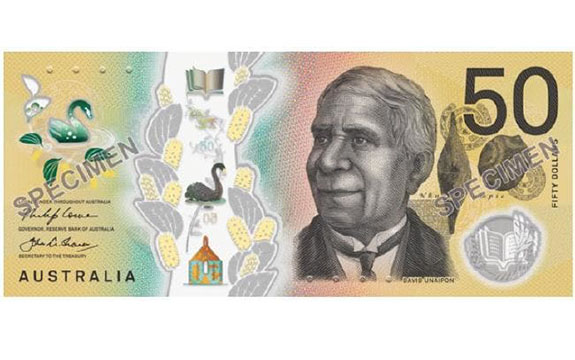Swinburne researcher contributes to the development of new 50 dollar note

In Summary
- Senior lecturer in Indigenous Studies, Dr Karen Hughes, was the subject matter expert for the David Unaipon side of the new note
- Dr Hughes has worked with the Reserve Bank of Australia on the note design since 2015
- The note has new security features, designs and quotes
Swinburne’s Dr Karen Hughes has led the research behind the design of one side of the new Australian 50 dollar bank note that features celebrated Indigenous Australian David Unaipon.
A senior lecturer in Indigenous Studies and expert in Ngarrindjeri history, Dr Hughes has been researching the life of the revered elder of the Ngarrindjeri people.
An inventor, scholar, author, lay preacher and activist, David Unaipon has featured on the 50 dollar note since 1995 to commemorate his extensive contribution to Australian society.
Dr Hughes has been working with the Reserve Bank of Australia on the development of the note since 2015, and says the process has been extremely thorough.
“Each side of every banknote has its own historian, ornithologist and botanist. You might not consider that so much research is involved, but it is a really extensive and rigorous process, in keeping with the banknote’s high public profile and longevity, and also its educative role,” Dr Hughes says.
“The final design is the culmination of three years of historical research in which I searched most major national archive collections to find the narrative elements, text and images for the note.”
New features

The Reserve Bank of Australia officially released the note on Thursday 18 October.
The note features a number of new designs, each of which has been carefully researched and selected by Dr Hughes to tell the story of David Unaipon’s contributions to the nation.
“The narrative data has to be very specific because of the space limitations and the method by which the designs are placed onto the notes,” she says.
Among the changes to the note is the addition of a black swan, known to be David Unaipon’s totem, or ‘ngaitji’.
“In Ngarrindjeri culture, your ngaitji, or totem, is your closest relation, friend and protector through life. This can be an animal or other animate being, or an element, such as the wind or rain,” Dr Hughes says.
There are also updated security features, an updated portrait of David Unaipon, the Point McLeay Mission church, native wattle flowers, and 18th century Ngarrindjeri shields representing technologies that inspired his inventions.
“The microprint also includes excerpts of Unaipon's book, Legendary Tales of the Australian Aborigines,” Dr Hughes says.
Dr Hughes’ research
Dr Hughes is passionate about the importance of sharing Indigenous histories and culture and is pleased to have been able to contribute to this project.
“The First Peoples of Australia’s stories and knowledge is foundational to the nation. David Unaipon was a great scholar, activist and inventor. He is one of many Indigenous Australians, some celebrated and many others whose lives are less public, whose contributions are vital to who we are as a nation.”
Dr Hughes has been a researcher and lecturer at Swinburne for seven years and regularly works closely with the Ngarrindjeri community in South Australia.
Currently, she is working on a research project in association with the University of Sydney, looking at the fate of the children born to Indigenous mothers and American servicemen stationed in Australia during World War Two, funded by the Australian Research Council.

